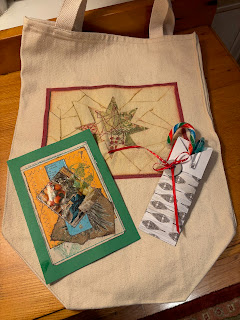For the last month of the year, the challenge was to write a haibun or haiga.
The haibun is is a poetic form first created by Matsuo Basho. It is a form that combines two modes of writing—prose and verse. Here are some of the "rules" of writing haibun, as suggested by the Haiku Society of America.
Prose in Haibun
- Tells the story
- Gives information, defines the theme
- Creates a mood through tone
- Provides a background to spotlight the haiku
Haiku in Haibun
- Moves the story forward
- Takes the narrative in another direction
- Adds insight or another dimension to the prose
- Resolves the conflict in an unpredictable way, or questions the resolution of the prose.
- Prose is the narrative and haiku is the revelation or the reaction.
In a haibun, the prose can come first, last, or between any number of haiku.
Haibun also have a title, something haiku generally do not.
You can read some examples and see different haibun forms at More than the Birds, Bees, and Trees: A Closer Look at Writing Haibun.
Haiga are poems that blend an image and haiku. Here is an introduction written by Ray Rasmussen.
Haiga is a mix of image and either haiku or tanka poetry. Its origins are in Japan where poet-artists used a mix of brushstroke painting and calligraphy to compose their images and poetry.
The poetic spark of haiga has to do with four elements:
- the quality of the image and its type
- the quality of the haiku (or tanka or short poem)
- the quality, type and placement of the text
- the quality of the framing of the image
Of course, the relationship of the haiku to the image is incredibly important. Do they enhance each other, making the haiga greater than the sum of its two parts?
This is a lot of background for a tiny poem. I have been playing around with block printing this month, so I created my own image and then wrote an introduction and a haiku, so this poem is a bit of haibun and haiga, though I'm not sure I followed the rules for either with any kind of fidelity.
Longing for Winter
In my youth, winter days were filled with endless hours outside, sledding, skating, shoveling, and building snow forts and an endless parade of snowmen. Whole families populated the yard, festooned with coal, carrot stick noses, and the scarves and hats we could sneak out of the house. Cold and lake effect snow ensured families lasted through the season, disappearing only with the blossoming spring.
climate change no myth
blizzards lamentably rare
snowmen live in dreams
You can find the poems shared by my Poetry Sisters at the links below.
- Tanita Davis
- Mary Lee Hahn
- Sara Lewis Holmes
- Kelly Ramsdell
- Laura Purdie Salas
- Liz Garton Scanlon
Michelle Kogan is hosting Poetry Friday this week. I hope you'll take some time to check out all the poetic things being shared today. Happy Poetry Friday, friends!

.png)


